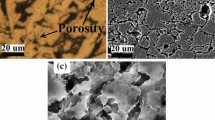Abstract
Alloying stainless steels with nitrogen has distinct advantages. Nitrogen is a strong austenite stabilizer and a potent solid-solution strengthener, and nitrogen has greater solubility than carbon in iron. This study investigates the relationship among nitrogen concentration, precipitate microstructure, and abrasive wear using two high-nitrogen stainless steel alloys: Fe-19Cr-5Mn-5Ni-3Mo (SSI) and Fe-16Cr-7Mn-5Ni (SS2). Alloy SSI contained 0.7 wt% N and was solution annealed at 1150 °C, thereby dissolving the nitrogen interstitially in the austenite. Subsequent aging, or cold work and aging, at 900 °C led to the grain-boundary, cellular, and transgranular precipitation of Cr 2 N. Alloy SS2 was remelted in a highpressure (200 MPa) N 2 atmosphere, leading to a spatial gradient of nitrogen in the alloy in the form of interstitial nitrogen and Cr 2 N and CrN precipitates. Nitrogen contents varied from a low of approximately 0.7 wt % at the bottom of the billet to a high of 3.6 wt % at the top. Nitrogen in excess of approximately 0.7 wt% formed increasingly coarser and more numerous Cr 2 N and CrN precipitates. The precipitate morphology created in alloy SSI due to aging, or cold work and aging, had little effect on the abrasive wear of the alloy. However, a decrease in the abrasive wear rate in alloy SS2 was observed to correspond to the increase in number and size of the Cr 2 N and CrN precipitates.
Similar content being viewed by others
References
R.P. Reed.y.Met., March 1989, p 16
M.O. Speidel and R.M. Pedrazzoli, High Nitrogen Stainless Steels in Chloride Solutions,Mater. Perform., Vol 31(No. 9), 1992, p 59
R.D. Pehlke and J.F. Elliott, Solubility of Nitrogen in Liquid Iron Alloys. 1. Thermodynamics,Trans. AIME, Vol 218, Dec 1960, p 1088
A.H. Satir-Kolorz and H.K. Feichtinger, On the Solubility of Ni- trogen in Liquid Iron and Steel Alloys Using Elevated Pressure,Z. Metallkd., Vol 82(No. 9), 1991, p 689
J.C. Rawers, N.A. Gokcen, and R.D. Pehlke, High Nitrogen Concentration in Fe-Cr-Ni Alloys,Metall. Trans. A, Vol 24A, Jan 1993,p 73
K.J. Irvine, D.T. Llewellyn, and F.B. Pickering, High-Strength Austenitic Stainless Steels,J. Iron Steel Inst., Vol 199, 1961, p 153
G. Stein, J. Menzel, and H. Dorr, Industrial Manufacture of Massively Nitrogen-Alloyed Steels,Proc. Int. Conf. on High Nitrogen Steels, J. Foct and A. Hendry, Ed., Institute of Metals, London, 1989,p 32
M.L.G. Byrnes, M. Grujicic, and W.S. Owen, Nitrogen Strengthening of a Stable Austenitic Stainless Steel,Acta Metall., Vol 35(No. 7), 1987, p 1853
M. Harsenmoser et al., The Influence of Nickel and Nitrogen on the Mechanical Properties of High-Nitrogen Austenitic Steels at Cryogenic Temperatures,Proc. 2nd Int. Conf. on High Nitrogen Steels, G. Stein and H. Witulski, Ed., Verlag Stahleisen, Dusseldorf, 1990, p 197
G. Stein, J. Menzel, and M. Wagner, N-Alloyed Steels for Retaining Rings and Other Applications,Proc. 2nd Int. Conf. on High Nitrogen Steels, G. Stein and H. Witulski, Ed., Verlag Stahleisen, Dusseldorf, 1990, p 399
A. Nyilas and B. Obst, Tensile and Fracture Properties of High Nitrogen Bearing Austenitic Steels at Cryogenic Temperatures,Proc. Int. Conf. on High Nitrogen Steels, J. Foct and A. Hendry. Ed., Institute of Metals, London, 1989, p 194
R. Ebner, M. Panzenbock, and H. Aigner, Metallurgical Factors Affecting the Fatigue Properties of High Strength Cr-Mn-N Steels,Proc. 2nd Int. Conf on High Nitrogen Steels, G. Stein and H. Witulski, Ed., Verlag Stahleisen, Dusseldorf, 1990, p 177
Metals Handbook, 9th ed., Vol 3,Properties and Selection: Stainless Steels, Tool Materials, and Special-Purpose Metals, ASM International, 1980, p 19–23
J.W. Simmons, J.C. Rawers, and D.G. Atteridge, Low-Ductility Room Temperature Impact Fracture of High-Nitrogen Austenitic Stainless Steels Induced by Transgranular and Grain Boundary Nitrides,Microstructural Science, Vol 21, International Metallographie Society and ASM International, 1992
H. Chandra Holm, P.J. Uggowitzer, and M.O. Speidel, Influence of Annealing Temperature on the Microstructure and Mechanical Properties of a High Nitrogen Containing Austenitic Stainless Steel,Sct: Metall., Vol 21, 1987, p 513
J. Menzel, G. Stein, and P. Dahlmann, Manufacture of N-Alloyed Steels in a 20t PESR Furnace,Proc. 2nd Int. Conf on High Nitrogen Steels, G. Stein and H. Witulski, Ed., Verlag Stahleisen, Dusseldorf, 1990, p 365
R. Blickensderfer and G. Laird II, A Pin-on-Drum Abrasive Wear Test and Comparison with Other Pin Tests.J. Test. Eval., Vol 16, 1988, p 516
M. Kikuchi, M. Kajihara, and S. Choi, Cellular Precipitation Involving Both Substitutional and Interstitial Solutes: Cellular Precipitation of Cr2N in Cr-Ni Austenitic Steels,Mater. Sci. Eng., Vol A146, 1991 p 131
Author information
Authors and Affiliations
Rights and permissions
About this article
Cite this article
Hawk, J.A., Simmons, J.W. & Raviers, J.C. Effect of nitrogen alloying on the microstructure and abrasive wear of stainless steels. JMEP 3, 259–272 (1994). https://doi.org/10.1007/BF02645852
Issue Date:
DOI: https://doi.org/10.1007/BF02645852




